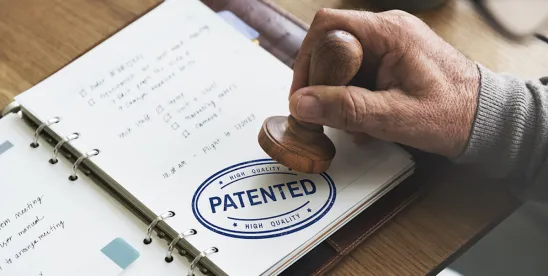Three intertwined legal mechanisms within U.S. patent law routinely complicate strategic planning for patent owners:
- Obviousness-Type Double Patenting (ODP): Bars the issuance of a second patent, which lacks patentable distinction from an earlier patent and would extend the patent term beyond that of the earlier patent, thereby preventing unjustified term extension. A terminal disclaimer (TD) is typically required when ODP is found.
- Patent Term Adjustment (PTA): Extends the patent term beyond the statutory 20-year period to offset United States Patent and Trademark Office administrative delays, under 35 U.S.C. §154(b).
- Patent Term Extension (PTE): Compensates for time lost during regulatory review when a product undergoes evaluation by a qualifying federal agency. Under 35 U.S.C. §156, PTE can extend a patent's term by up to five years, but the total effective patent life following regulatory approval is capped at 14 years.
Recent court rulings have redefined the application of ODP with respect to patents extended through PTA or PTE.
Recent Case Law Implications
In its pivotal decision in In re Cellect (81 F.4th 1216 (Fed. Cir. 2023)), the Federal Circuit held that ODP applies even when the later patent’s extended term arises solely from PTA, potentially requiring a TD to address ODP even if PTA is the only basis for the extended term. This contradicts earlier understandings that PTA would not trigger ODP concerns unless there was some form of manipulative conduct. After the In re Cellect decision, ODP applies regardless of intent or good faith and must be assessed based on the actual expiration date, which includes any PTA. The presence of manipulation is now irrelevant; what matters is whether a later-expiring patent is not patentably distinct from an earlier one. If it is not, it may be invalid for ODP if a TD is not filed.
Conversely, when the extended term arises from PTE, courts – including the Federal Circuit in Novartis AG v. Ezra Ventures LLC (909 F.3d 1367 (Fed. Cir. 2018)) – have held that ODP does not bar the extended term. The Federal Circuit emphasized that PTE’s distinct statutory goal is restoring lost patent term due to regulatory review, and ODP should be evaluated against the original, nonextended term. While policy considerations around public access to essential therapies support this reasoning, the ruling establishes a broader protection for PTE-extended terms irrespective of the type of treatment involved.
These rulings create a nuanced framework where PTA makes patents more vulnerable to ODP challenges while PTE stays largely shielded. The Cellect decision effectively means that PTA can be nullified by ODP even if the USPTO caused the delay. This creates a significant risk for patents that rely on PTA to extend their term, especially in industries like pharma and biotech, where each day of exclusivity counts. Lower courts have already applied the ruling in Allergan USA, Inc. v. MSN Laboratories Private Ltd (694 F. Supp. 3d 511 (D. Del. 2023)) and Acadia Pharms. Inc. v. Aurobindo Pharma Ltd (No. 1:20-cv-00985-GBW, 2023 WL 8622048 (D. Del. Dec. 13, 2023)), and helped clarify its scope.
In Allergan, the district court invalidated claims in a patent extended by PTA under ODP, citing Cellect, ruling that a first-filed, first-issued, later-expiring patent could be invalidated by a later-filed, earlier-expiring patent sharing a priority date. The Federal Circuit reversed, clarifying that Cellect does not support using later-filed patents as ODP references against earlier-filed ones, especially where that issue was not raised below. The Federal Circuit emphasized that ODP guards against unjust term extensions via duplicative patents, not earlier patents finalized before child claims existed. It found it unreasonable to require patentees to disclaim a statutorily granted term due to later filings, concluding that the first-filed, first-issued patent sets the exclusivity limit for the invention and its patentably indistinct variants.
In Acadia, the court distinguished the facts from Allergan and clarified that later-filed patents cannot serve as proper ODP references against earlier-filed patents, emphasizing the absence of prosecutorial gamesmanship. The Federal Circuit affirmed, applying their holding in Allergan: a first-filed, first-issued, later-expiring claim cannot be invalidated by a later-filed, later-issued, earlier-expiring reference claim having a common priority date. This helps define the limits of In re Cellect, which addresses ODP in the context of PTA-extended terms, but does not apply to invalidate PTA-extended terms in earlier-filed patents based on later-filed references. While equitable considerations may still influence ODP outcomes, their impact remains highly fact-specific.
Thus, PTA is added before ODP analysis, making it vulnerable to ODP challenges, while PTE is added after ODP analysis, providing stronger protection.
Practice Tips
Avoiding TDs and mitigating ODP risk requires a proactive, strategic approach, especially in the wake of recent case law. To better protect the full patent term without resorting to TDs, practitioners should consider the following.
- Strategize Claim Differentiation in Initial Drafting
Claim drafting should anticipate potential ODP concerns. This includes minimizing overlapping claim scope with related applications and proactively distinguishing claims to demonstrate patentable distinctiveness. Applicants can also file new applications claiming results of clinical trials, possibly allowing them to argue separate patentability (even over issued species claims).
For genus/species claims, issue the genus first to establish foundational scope. Subsequent species claims should show clear differentiation. Patent applicants should avoid prosecution statements suggesting the narrower claims lack distinctiveness, as such admissions may trigger ODP investigation.
- Keep Strategic Continuations Pending
Strategically file continuation and divisional applications to control overlapping terms and reduce PTA-triggering delays. This preserves flexibility for real-time adjustments in claim scope and tactical responses to shifting ODP case law.
- Leverage USPTO Restriction Practice to Your Advantage
Smart use of USPTO restriction practice can shield patents from ODP. By provoking a restriction early, applicants can unlock safe harbor under 35 U.S.C. §121 if divisional filings maintain strict adherence with original claim groupings.
- Challenge ODP Assertions
Do not accept ODP at face value, especially where PTA is involved. If possible, cite Cellect and argue that the claims are patentably distinct.
Applicants can also file an Information Disclosure Statement listing co-owned or related patent filings for ODP review. Absent a rejection, the examiner is deemed to have found no overlap warranting ODP.
- Be Cautious with TDs
While TDs are a common fix for ODP, they can forfeit valuable PTA-based term extensions. Explore all viable alternatives that preserve statutory exclusivity and use TDs only as a last resort.
If a TD is needed, file it before the PTE is calculated in order to maximize PTE. Additionally, do not disclaim over a date certain, and provide exception situations where the patent over which you are disclaiming expires for failure to pay maintenance fees or is found to be invalid or unpatentable.
- Audit for ODP Vulnerability
Routinely review your portfolios to identify PTA-extended filings that might face ODP risks due to earlier-expiring family members. If claim scope or timing raises concern, consider post-grant strategies such as amendments, disclaimers, or positioning for litigation.
Final Thoughts
Patent holders must remain alert as evolving case law reshapes the relationship between PTA, PTE, and ODP. Recent rulings have spotlighted how patent term adjustments can produce term disparities that invite ODP challenges. While PTE remains protected from such scrutiny, PTA can render related patents more vulnerable if expiration dates diverge. To preserve full patent exclusivity, practitioners should monitor developments closely and adapt prosecution, portfolio, and litigation strategies accordingly.





 />i
/>i

